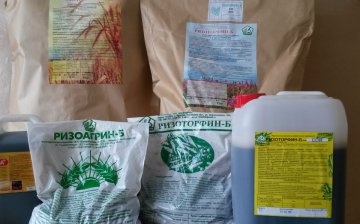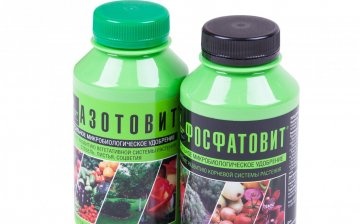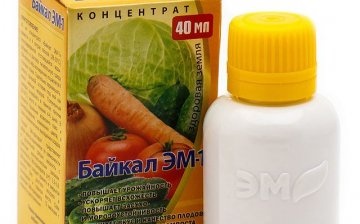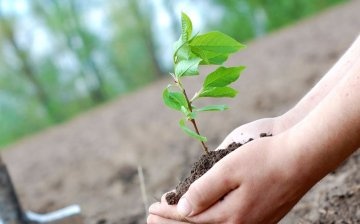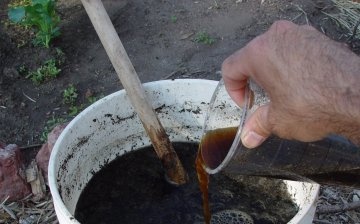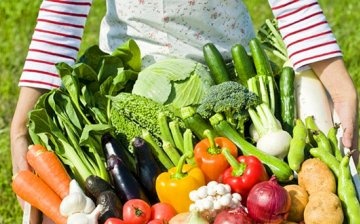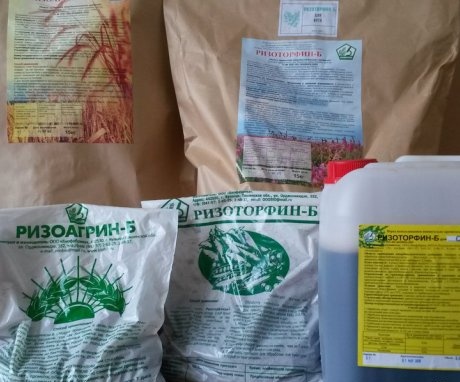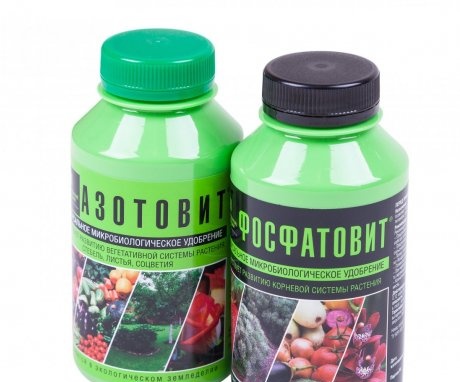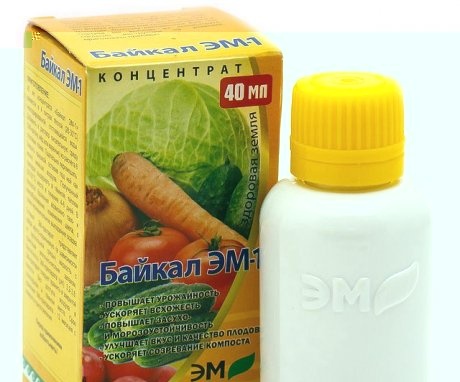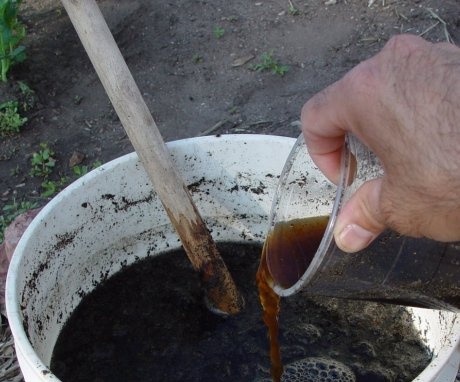Biofertilizers for the garden and vegetable garden: a review of the best drugs
Gardeners began to abandon purchased "chemicals". It quickly neutralizes the problems arising with planting, but at the same time, when exposed to it, all the beneficial qualities of the grown fruits are lost. Therefore, many gardeners and flower growers resort to using biofertilizers. They have a beneficial effect on the soil and planting. To know which organic additives need to be used, you need to understand their meaning, types, advantages and disadvantages, both for the garden and for the vegetable garden.
Content:
- The value and types of biofertilizers
- The best biofertilizers for the garden and their effect
- The best biofertilizers for the garden and their effect
- When and how to use biofertilizers correctly?
- How to prepare biofertilizer with your own hands?
- Advantages and disadvantages of using biofertilizers
The value and types of biofertilizers
Biofertilizers - means of plant nature, belonging to the group of natural fertilizers. Their formation occurs in the process of oxygen-free fermentation of such organic substances as cattle manure, bird droppings and plant particles of dead plants. The difference from mineral complex fertilizers is the absence in the composition of biofertilizers of the ability to accumulate nitrates in the structure of the cultivated culture. Also, the content of the soil substrate is not saturated with negative substances. The peculiarity of natural dressings is that they are completely absorbed by plants.
With an oxygen-free fermentation technique, all microorganisms with the help of which the processing takes place contribute to the complete preservation of nitrogen-containing substances.
When carrying out the procedure of reheating biofertilizer, difficultly soluble components, such as phytic acid and phosphate, are combined, potassium and phosphorus are preserved in the soil substrate. During the process, the ability of beneficial bacteria to combine nitrogen and transport it into the substance is revealed. The latter is necessary for the plant to easily and fully absorb the agent. Additionally, this additive stimulates an increase in the quality of growth of flowers and agricultural plants.
A dietary supplement can be obtained by preparing the product yourself, or purchased at a specialized flower shop. In the industrial preparation of organic additives, the whole process is reduced to the accumulation and preservation of bacterial viable cells. This procedure is performed using an aseptic microbiological process. A kind of classification has been formed among biofertilizers. But to bring all types of dressings back to normal is problematic. This is due to the fact that one remedy can belong to one group and to another.
There are several main groups:
- Bacterial - their effect on the soil is aimed at the accumulation in the soil of the 3 substances most necessary for crops - nitrogen, phosphorus, and potassium. Nitrogen is most rapidly washed out of the soil, but with a large volume it stimulates the plant to grow excessively greenery.In most cases, phosphorus enters the ground in a poorly soluble form, therefore, the root system is not always able to absorb fertilizer. Potassium penetrates best of all into the soil substrate. It is contained in the soil for a long period, saturating the bush with nutrition, and stimulates the ability to develop qualitatively.
- Fungal - fertilizers for various plants and vegetables, developed on the basis of fungal formations. Such a solution stimulates the decomposition of organic residues into enzymes, transforming their composition into a mineral agent. The latter is necessary for plant drinks with essential nutrients.
- Based on EM technologies - specific microorganisms are used to develop this type of fertilizer, designed to effectively improve the quality of the soil, which, as a result, leads to an increase in the yield of planted crops in the fertilized garden plot. When using such products, no toxic type chemicals or mineral fertilizers are used. Additional properties of biofertilizers reveal an increase in the resistance of the shrub to a low temperature regime, as well as the improvement of vegetables, fruits or flowers that are often exposed to diseases.
- Humic - to obtain this class of fertilizers for a long period, studies of the ongoing biological processes in the soil took place. Through such a survey, scientists have developed a humic-type biofertilizer, which is primarily involved in the decomposition of organic compounds, while promoting their transformation into fertile elements. Humates are obtained from brown coal, peat or sapropel, as well as potassium and sodium. These funds are necessary for soaking the planting material before rooting, tubers and rhizomes are treated with it during transplantation. Flower feeding is carried out during the growing season and before going to rest.
Before the impact of biofertilizer on the soil, you should carefully study what it is used for, which microorganisms it affects and what is the benefit of the plant from their action. Fertilizing of an organic nature is not of the same type, it is divided into species, some of which are more suitable for use as fertilizer for flowers, others for vegetable plants.
The best biofertilizers for the garden and their effect
All biofertilizers are distinguished by good qualities, allowing to maintain the plant, increase resistance to parasites and pests, and also prevent the development of diseases. Some are excellent at improving the quality and volume of the harvested crop. But the drugs are different. Some are more suitable for a vegetable garden, while others are recommended to process bushes and trees of fruit and berry crops.
The following natural fertilizers are distinguished, which have the most beneficial effect on plants located in the garden:
- Azotovit is a fertilizer from the class of bacterial agents. It comes in a convenient 200 ml plastic bottle. Differs in increased efficiency, due to the complex effect. Promotes the formation of vegetative organs of a shrub or tree. Reduces the content of various negative substances in fruits, including nitrates. Reduces the likelihood of developing fungal diseases. Increases plant resistance to changes in weather conditions. The tool can be used to treat seeds before planting, as well as periodically apply root dressing during the growing season of the culture.
- Bisolbifit or Extrasol - preparations were developed by domestic scientists from natural basal materials. The first of the fertilizers is sold in dry form, the second can be purchased in a liquid state. They have the ability to stimulate the development of bacteria that inhibit the formation of fungal spores or the addition of bacterial diseases.The drug is intended to increase the immunity of the plant, as well as to prevent the prerequisites for the occurrence of diseases after a stressful situation (transplant, strong pruning).
- Rostmoment is made on the basis of fungi. It stimulates an increase in the plant's defenses against pests and bacteria, promotes the fastest growth and development of seedlings and young shoots. Favorably affects the early blooming of fruit plants. Increases the palatability of berries and fruits, increases the nutritional value of fruits and affects the long-term storage of the harvested crop.
- Biorost is a product developed using EM technologies. The drug, when added to the soil, stimulates increased productivity. When it is introduced into depleted soil, top dressing is able to add an increased number of nutrients, which has a beneficial effect on obtaining a normal amount of fruit.
For each drug, an individual instruction has been developed, thanks to which it is necessary to irrigate fruit crops located on a personal plot.
The best biofertilizers for the garden and their effect
Almost all natural remedies are suitable for crops. The following substances are distinguished, which have an excellent effect on the increased yield and quality of vegetables:
- Nitragin is a bacterial-type drug. It is used mainly to influence large areas used at the industrial level for the cultivation of huge yields of vegetable crops. With its help, seeds are disinfected before planting, the soil is saturated to obtain nitrogen-containing nutrients.
- Phosphatovit - a means necessary for the formation of potassium and phosphorus in the soil. Thanks to this process, vegetable crops are saturated with nutrition. When the agent is exposed to the shrub, the leaf plates, tubers and root system are protected from the invasion of parasites and the elimination of pathogenic bacteria.
- Globioma biota max is a fungal agent. It is realized in the form of small tablets, which include 4 strong trichoderma fungus. The main effect of the tool is aimed at eliminating pests from plantings, as well as increasing yields in the treated area. This is done by restoring normal microflora. The substance blocks the leaching of nutrients from the soil substrate, especially nitrogen.
- Baikal EM-1 is the most famous and respected drug among the products developed on the basis of EM technologies. It is recommended for use as a fertilizer for various vegetables, potatoes, sugar beets and for growing rice. In some cases, the yield increase was 1.5 times, 2 and even 3 times the usual harvested volume.
The results of the effect of the additive was the identification of a lesser negative effect on crops, the plants ceased to be massively ill. After feeding, the fruits became much larger, fruiting lasted in terms of time. In addition, plants that tend to winter have increased their frost resistance.
When and how to use biofertilizers correctly?
In order to acquire the necessary nutrient, one should first determine the soil and select the desired biological composition. For this, the type of soil is identified. The procedure is carried out using laboratory exposure or folk methods.
If the choice fell on phosphorus fertilizers, then they are found to be useful for any soil substrate. If the soil is neutral, then it needs nitrogen-containing fertilizing. Such an effect will stimulate good vegetation of the plant. Additionally, an examination should be carried out to identify the individual needs of the culture planted in this area. Certain vegetables require increased nitrogen input. These plants include cucumbers, White cabbage, potatoes and tomato... The area where berry bushes are located should be fertilized with phosphorus fertilizers.
Top dressing must be applied along with the seedlings transplanted to a new place of residence.
Pre-planting material should be soaked in a diluted solution. The seeds are also soaked in the product before planting. Other products based on natural ingredients are added to the soil after the first shoots appear, as well as during the entire growing season no more than 1 time per month. Each drug has its own instruction, which is located on the wrapper on the back of the drug package. An improperly diluted consistency with increased amounts of the product affects the increased growth of greenery on the bush and the absence of fruits. With an insufficient amount of biofertilizer in the solution, the drug will not give the expected result.
How to prepare biofertilizer with your own hands?
You don't have to buy industrially obtained biofertilizers in the store, but prepare the required consistency with your own hands. There are 3 ways to make a nutrient:
- From yeast - for cooking, you should take 1 kg of "live" or pressed baker's yeast. This volume is diluted in water, with a volume of 5 liters. The resulting consistency must be kept for 3-4 hours. Before applying top dressing, it must be diluted in a ratio of 1 to 10. If there is no compressed yeast, you can take dry yeast. The recipe for the preparation is identical. In this case, before depositing the funds, it is necessary to dilute 10 g by 10 liters. liquids. In this case, 4-5 tbsp must be made. sugar To enhance the effect, you need to add wood ash and chicken droppings in a volume of 0.5 kg per bucket of funds. Let this consistency brew for up to 3 hours. After that, also dilute 1 to 5.
- To get Azotovit you need 1 tbsp. combine humus with 250 ml. water. Additionally, 2 tsp are added. lime or chalk, as well as superphosphate in a volume of 5 grams. The mixture is mixed, on the basis of the resulting consistency, a layer is formed with a thickening of 10 cm. Having prepared the product, it must be covered with cellophane and placed in a darkened room. Withstand the resulting drug in this state for 7 days. After that, a kind of mucus appears on the surface of the batch - azotobacter. It is collected and dried. This powder is recommended for soaking seeds and for spraying the surface of the ground and green plantings.
- To prepare Rizotorfin, mix grass and weeds in one container. Pour all this with water, close the bucket and expose it in direct sunlight. After fermentation starts, add 1/3 of additional water. After 7 days, the resulting product is poured into a compost pit. The tool is necessary for adding to the holes when planting seedlings, as well as for fertilizing the earth and mixing with dry peat.
Using simple recipes, you can easily make with your own hands an effective tool for increasing yields and saturating fruits with excellent taste. The main thing is that all the ingredients for the preparation of biofertilizers can be easily purchased and picked on their own (grass, weeds).
Advantages and disadvantages of using biofertilizers
The funds have practically no drawbacks. The only drawback is that if you increase the amount of fertilizing supplied to the ground, it can provoke a strong growth of the green part of a shrub or plant. In such a situation, all the energy of the culture will be directed towards growth, while the fruits will practically not be formed. But at certain points in the life of young plants, such a rapid growth is simply necessary.
The advantages of biofertilizers are:
- Improving soil microflora and bringing it back to normal after a disease or plants that deplete the soil.
- Elimination of pathogenic bacteria and neutralization of microorganisms living on seeds or in the soil.
- Stimulates the preservation of all nutrients in the soil, prevents them from being washed out of the soil. Thanks to this, all nutrients go directly to the plantings.
The most important advantage over mineral substances developed with the use of chemistry is that biofertilizers do not accumulate in the thickness of the fruit in the form of nitrates. On the contrary, the fruits, thanks to this introduction of nutrients, acquire volumes and distinctive taste.
Thus, biofertilizers are necessary to combat pathogenic microflora, increase the yield and quality of harvested fruits, fruits and vegetables. The main thing is to correctly observe the norms for entering into the ground and foliar spraying, and also carefully select the necessary agent before use.
More information can be found in the video:




